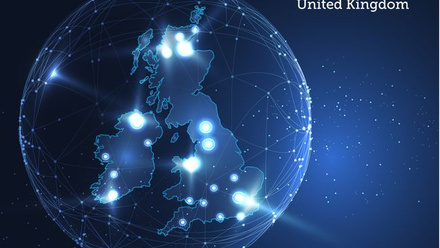Announcing techUK's final Geospatial Champion of the year!

Congrats to Charles Kennelly, CTO, at ESRI UK for being techUK's Geospatial Champion
The purpose of techUK’s Geospatial Champion campaign is to celebrate the work of those pushing forward adoption of Geospatial in the tech sector. This is also an opportunity to learn from those working in Geospatial about the current landscape and examples of the strides being made in enhancing awareness.
What is your current role and what does a typical day involve?
I am the Chief Technology Officer at Esri UK. My days are usually split between developing and implementing our strategy across Esri UK and Esri Inc., working with strategic customers, promoting the role of GIS externally, governance for projects and initiatives, helping run the company and learning from my colleagues.
Why is geospatial data valuable to the UK?
I would actually reframe this question. “Why is data valuable to the UK?”.
Geospatial information is such a fundamental part of most datasets that without location information those datasets are incomplete.
What I would advocate is use geospatial techniques to extract the greatest value from the data we use across society everyday.
Do you think the conversation around geospatial data is changing in the UK? Why/ why not?
The conversation around geospatial data has changed massively over the last few years due to many factors. The internet provides easy and fast access to location services such as routing and almost everyone uses a Sat Nav from time to time. Increased availability of data and software at a lower cost coupled with technical advances has driven use and demand. But that conversation is still in its infancy. My expectation is that the conversation will lead to a greater understanding of how to use location and greater exploitation in the wider data science and information sector where geospatial is underdeveloped.
How do we showcase the value of geospatial data to the technology sector?
Ask someone in the technology sector “what is geospatial data” and they may say “digital maps” or possibly the “data which is used to make digital maps”. Is this right? I would say yes and no.
For centuries maps have been used to communicate ownership, boundaries, navigation, perils and many other things in a way everyone can understand. Our maps today do the same thing. So yes, geospatial data is used to make maps but also offers a great deal more.
To really showcase the value of geospatial data today, we need to look beyond the map – behind it if you like and understand that it is, and always has been, a tool to integrate and aggregate information.
I often encounter systems that have been designed to integrate information from many sources and data silos. Many of these are overly complex, fragile and expensive to maintain.
Geospatial data and tools have the power to unify datasets and to underpin data science and information architectures, bringing information together, in a robust, efficient and inexpensive way. It’s this last point that we need to showcase.
What are your key concerns hindering increased deployment of geospatial data in the technology sector?
My key concern is that our IT and data science communities do not know how to fully leverage the power of geospatial relationships.
I often come across organisations trying to link heterogeneous systems via data harmonisation and common ontologies.
APIs & webservices give us a framework for asking questions of datasets and systems, geospatial approaches help us identify what specific system we should be asking a question of and how to frame it.
A knowledge of location and geospatial relationships is one of the most powerful means of linking systems together.
What steps can companies take to utilize spatial data in their products and services
Employ people with geospatial skills.
Can you give an example of where geospatial data has been adopted in an innovative and new way?
A water utility tracing downstream of a pipe repair task to identify affected customers and their average water use, arranging tankers with enough supply to inject water into the network below the pipe while the repair is carried out, so that those customers supply is never interrupted.
Activists using freely available timestamped historic satellite imager sequences combined with geospatial analysis tools to support the prosecution of companies trying to hide their illegal logging activities
Regarding data access and availability – what is the position of the UK and in what ways should we encourage data accessibility?
In terms of data access and availability, I think the UK is in a leading position, but with more to do.
We have witnessed great strides in the availability of open data and this is vitally important for reasons of transparency and accountability.
However the sharing of data does not equal the sharing of knowledge. To share knowledge, we must also share the expertise and analysis capabilities of the people who maintain the data. The technology and techniques exist to do this, with location providing the vital context through which data can be understood.
In respect of encouraging data accessibility, we need parity with our European neighbours - and by that I mean, the UK government should change the business model, to provide for the UK, unrestricted access to comprehensive mapping and address data. This would provide huge value across business and society.
How can we equip the next generation with the most appropriate skills for a future in geospatial?
Teach the fundamentals of geospatial analysis and design to data scientists and analysts as a foundational part of their curriculums. Teach it as a core information management technique. There will always be a place and a role for geospatial specialists, geographers and cartographers. However, the use of geospatial techniques to link, analyze and model our complex world should not be reserved for the geographer.
We hope you have enjoyed this series at techUK. Remember you can keep up to date with all techUK geospatial data activity here, or please do not hesitate to reach out

Rory Daniels
Rory joined techUK in June 2023 after three years in the Civil Service on its Fast Stream leadership development programme.

Ella Shuter
Ella joined techUK in July 2025 as Junior Programme Manager for Emerging Technologies.

Laura Foster
Laura is techUK’s Associate Director for Technology and Innovation.

Elis Thomas
Elis joined techUK in December 2023 as a Programme Manager for Tech and Innovation, focusing on Semiconductors and Digital ID.








